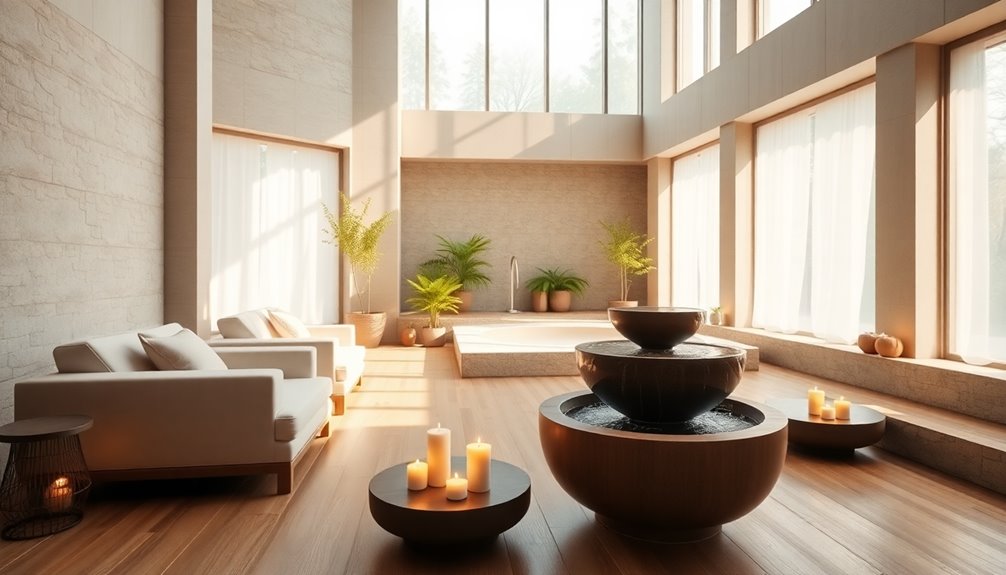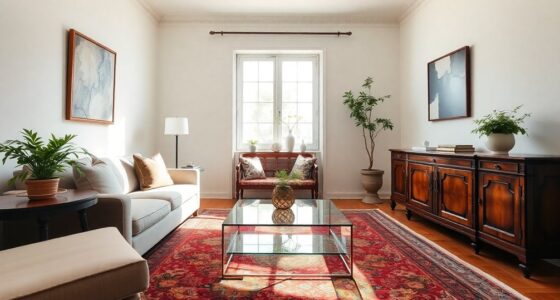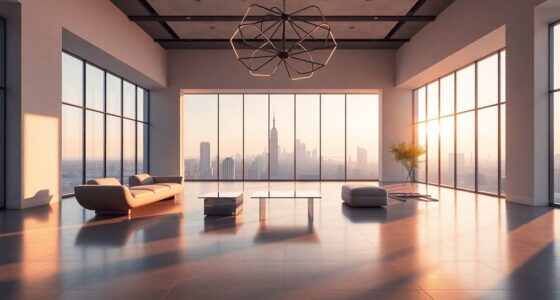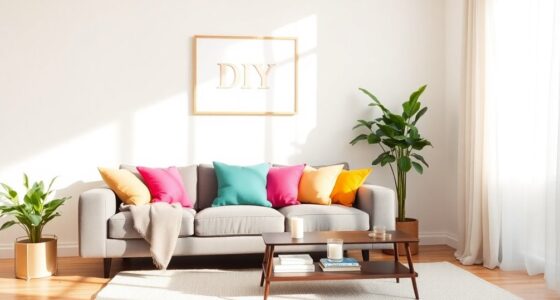Your spa interior design concept can transform any space into a sanctuary of serenity. Start by using calming color palettes like soft blues and greens to promote relaxation. Incorporate natural elements, including wood and stone, to create warmth and luxury. Choose comfy furnishings with premium textiles for an inviting atmosphere. Enhance the experience with aromatherapy, using diffusers and essential oils. Don’t forget to create soundscapes that include soothing music and ambient sounds for tranquility. With these ideas, you can design a space that truly feels like a retreat. Explore further for tips on practical implementation and enhancing sensory experiences. Incorporating elements of feng shui can further enhance the harmony of your spa interior, ensuring that energy flows freely throughout the space. Consider positioning furnishings in ways that promote an inviting atmosphere while balancing the elements, which aids in harmonizing home with feng shui. Finally, the use of soft lighting, such as dimmable fixtures or candles, can create an inviting glow that elevates relaxation and tranquility, making your sanctuary even more inviting.
Key Takeaways
- Utilize calming color palettes like soft blues and greens to create a serene and relaxing atmosphere in spa spaces.
- Incorporate natural elements such as wood, stone, and plants to promote warmth, luxury, and air purification.
- Choose comfortable furnishings with ergonomic designs and premium textiles to enhance relaxation and guest experience.
- Implement aromatherapy techniques with essential oils and candles to create personalized and soothing olfactory environments.
- Design soundscapes with acoustic panels and ambient noise machines to ensure tranquility and promote mindfulness.
Color Schemes and Lighting

Creating the right atmosphere in a spa relies heavily on color schemes and lighting.
You'll want to choose calming color palettes like soft blues, greens, and pale pinks to evoke relaxation. These hues can lower blood pressure and create a soothing environment. Incorporate warm earth tones for an earthy feel, while whites add warmth and interest. Research supports the calming effects of specific hues in wellness spaces. Moreover, the use of air purifiers can further enhance the serenity of the environment by improving air quality.
Strategic lighting is essential, too. Utilize soft, indirect brightness in relaxation areas and low-intensity lights in massage rooms.
Focal points of light around pools can guide guests and enhance visual interest. Accent lighting highlights key features, while diffused glow reduces harsh shadows.
Incorporating Natural Elements

How can you enhance the spa experience by incorporating natural elements?
Start by using wood accents in your flooring and furniture to create a warm, inviting atmosphere. Incorporate stone for countertops and accents, adding a touch of sustainability.
Don't forget to integrate plants; they'll not only purify the air but also infuse the space with vibrant energy. Maximize natural light with large windows or skylights, allowing sunlight to uplift the mood of the space. Natural light contributes significantly to a welcoming and rejuvenating environment.
Consider adding organic features like water fountains or zen gardens for soothing sounds.
Finally, enhance the ambiance with natural textures and earthy tones that promote a calming environment.
Choosing Comfortable Furnishings

Choosing comfortable furnishings is essential for crafting an inviting spa environment. Start with premium textiles for seating and bedding, enhancing overall comfort. Incorporate natural materials like wood and stone to create a serene ambiance, while marble or granite countertops add a touch of luxury. Opt for ergonomic designs, ensuring furniture provides optimal support.
To promote relaxation, include reclining seats and ergonomic chairs with contoured backrests. Plush seating areas invite lounging, and comfortable beds are vital for treatments. Additionally, using natural stone materials can further enhance the grounding aesthetics of the spa. Consider incorporating elements like natural sweetening alternatives such as honey in your spa menu, offering guests a delightful taste of wellness.
Soft, diffused lighting and neutral colors contribute to a calming atmosphere. Don't forget functional furniture that looks stylish, along with plush towels and heated massage tables for an elevated experience.
Prioritize quiet, private areas for ultimate tranquility and rejuvenation.
Utilizing Aromatherapy Techniques

Incorporating aromatherapy techniques into your spa's design amplifies the inviting atmosphere established by comfortable furnishings. Using diffusers filled with calming essential oils like lavender or chamomile creates a soothing environment that encourages relaxation. Additionally, the holistic practice of aromatherapy can influence mood and promote overall well-being. Strategically place scented candles throughout the space to enhance the aromatic experience, while personalizing diffusing zones for specific areas promotes tailored relaxation. In treatment rooms, utilize essential oils to elevate massages and facials, enhancing their soothing effects. Essential oils like eucalyptus in steam rooms provide respiratory relief, making the experience even more rejuvenating.
Creating Soundscapes and Acoustics
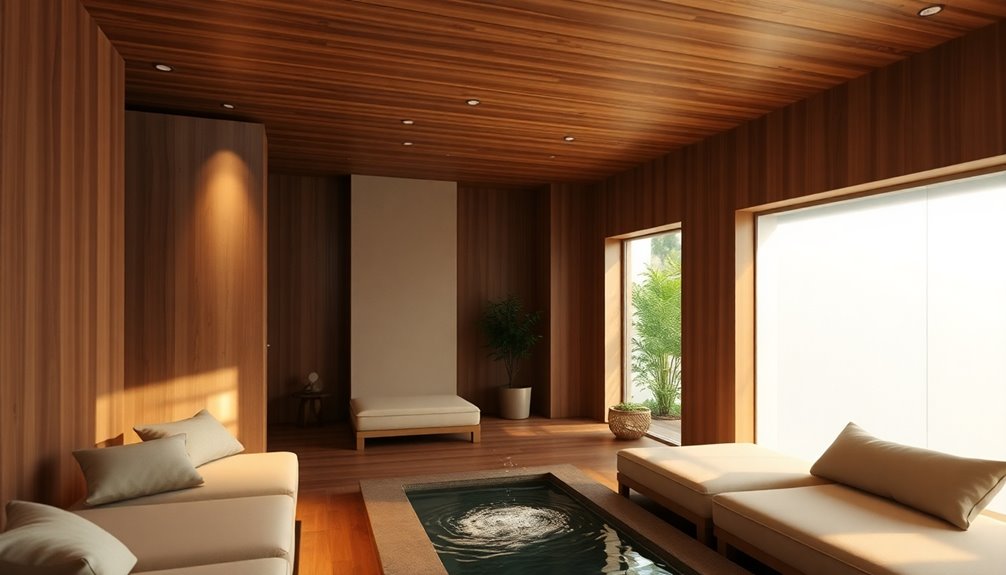
Creating a harmonious soundscape in your spa can significantly enhance the overall experience for your guests. Start by incorporating acoustic panels to absorb unwanted noise and prevent echo, ensuring a tranquil atmosphere. Use door seals and flooring underlayment to block disruptive sounds, creating a serene environment. Ambient noise machines can provide a soothing background, while strategic placement of sound-absorbing materials enhances the acoustic quality. Focus on sound design by considering the activities in each space. Soothing music and nature sounds can further promote relaxation, while calibrated speakers ensure optimal audio performance. Additionally, investing in acoustic-friendly materials can elevate both the aesthetics and sound quality of your spa environment. Collaborate with acoustic specialists to tailor solutions that meet your spa's specific needs, resulting in a peaceful oasis where guests can unwind and rejuvenate.
Enhancing Texture and Sensory Experiences
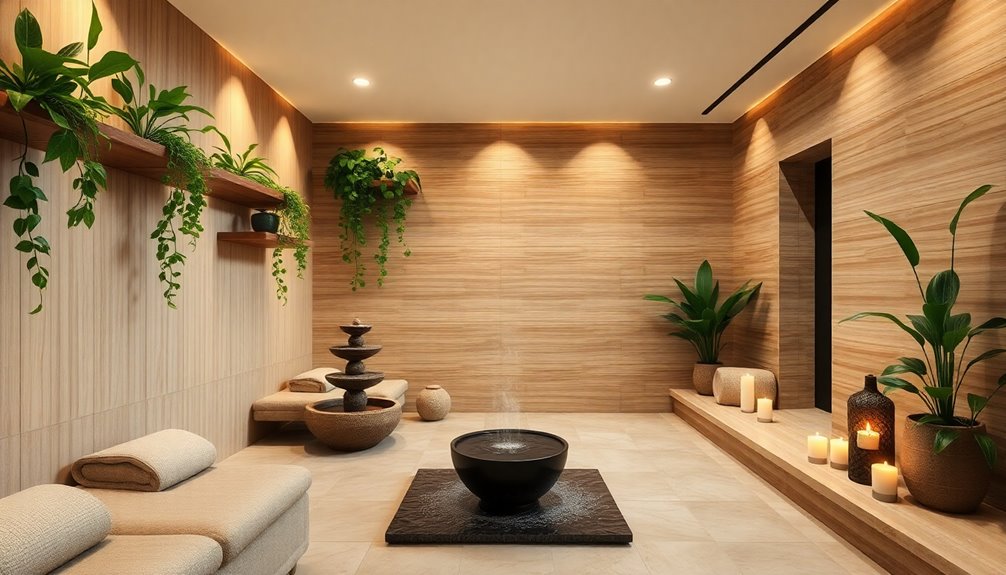
When guests step into your spa, the textures and sensory experiences you provide can instantly elevate their relaxation journey. Incorporating soft fabrics like plush robes and comfortable seating ensures they feel enveloped in luxury. Regular music sessions can aid in pain management and relaxation, enhancing the overall experience.
Utilize natural textures with wooden elements and smooth stone surfaces to create a harmonious atmosphere. For tactile experiences, consider heated massage tables and warm towel wraps that soothe the body. Engaging multiple senses through multisensory experiences can significantly enhance their overall well-being.
Integrate sensory elements, such as aromatherapy oils and calming scented candles, to engage their sense of smell. Enhance ambiance with textured walls and rugs, mixing materials like wood and fabric. The use of calming music can further promote relaxation and mindfulness throughout the spa environment.
Practical Implementation Tips
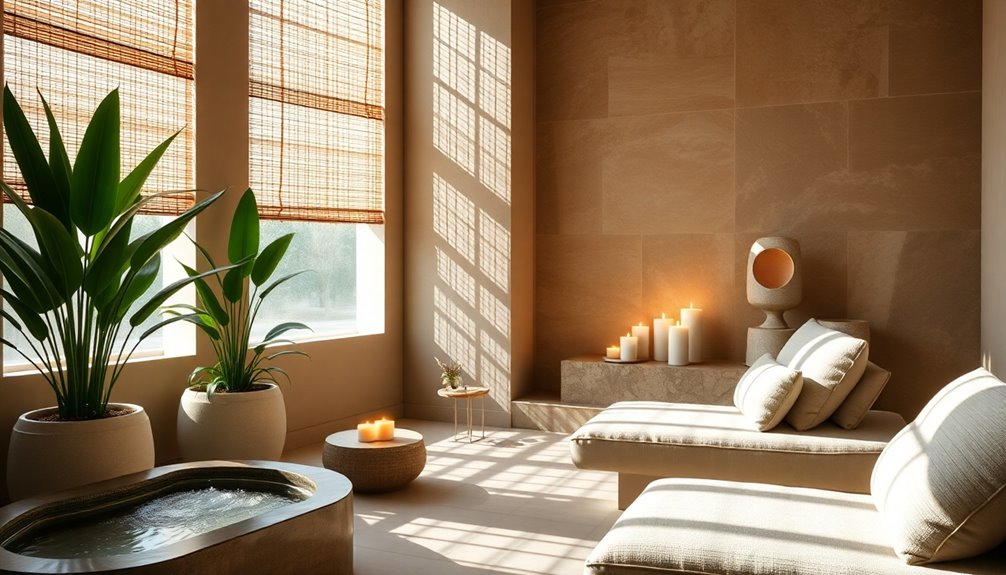
To transform your spa into a haven of relaxation, focus on practical implementation tips that enhance the overall experience.
Start by incorporating natural elements like wood, bamboo, and stone to create a serene atmosphere. Use plants to purify the air and add a calming scent, and consider water features for soothing sounds. Additionally, incorporating calming elements like artwork can further contribute to a soothing atmosphere. Integrating an air purifier with HEPA filtration can help ensure the air remains fresh and free of allergens.
Next, prioritize soft lighting with dimmable options and avoid bright fluorescents. Candles can also enhance the ambiance.
Choose functional furniture made from recyclable materials, and select plush upholstery for comfort and luxury.
Finally, invest in a quality sound system for calming music, create intimate spaces for relaxation, and block external noise to maintain tranquility.
These elements will elevate your spa experience significantly.
Frequently Asked Questions
How Do I Choose the Right Spa Location?
To choose the right spa location, start by understanding your target market's demographics and needs.
Analyze local competition and identify gaps in services. Ensure the site is accessible, visible, and compliant with zoning laws.
Assess the infrastructure, like ventilation and plumbing, to meet operational requirements.
Lastly, evaluate the local economy and household income levels to ensure economic viability.
This thorough approach will help you select a successful spa location.
What Is the Ideal Size for a Spa Room?
When considering the ideal size for a spa room, you'll want at least 90 to 110 square feet for standard treatment rooms.
If you're using medical devices, aim for 120-140 square feet.
Ensure there's at least 36 inches of clearance around the massage table for easy movement.
Don't forget to include space for a sink and storage.
For specialized treatments, larger rooms may be necessary to accommodate diagnostic tools and enhance guest comfort.
How Can I Ensure Privacy for Guests?
To ensure privacy for your guests, you can use a variety of strategies.
Start by installing tall fences or walls to block unwanted views. Incorporate landscaping, like tall hedges or potted bamboo, to create natural barriers.
Consider adding decorative solutions like privacy screens or outdoor curtains.
Lastly, don't overlook soundproofing measures—using acoustic materials and white noise can enhance the tranquil atmosphere, making guests feel secure and relaxed during their experience.
What Are the Benefits of Hiring a Professional Designer?
Hiring a professional designer brings numerous benefits.
They understand your needs and craft personalized solutions that reflect your style. With their expertise, you avoid costly mistakes and stay within budget.
Designers manage projects efficiently, handling details from start to finish, which reduces your stress. Plus, they've access to exclusive resources and materials, ensuring your space is both unique and high-quality.
Ultimately, they transform your vision into a stunning reality.
How Often Should I Update the Spa Interior Design?
Updating your spa interior design is like refreshing a garden; it keeps the environment vibrant and inviting.
You should aim to update every 3-5 years to maintain a modern look that meets client expectations. Regular maintenance is essential, too, ensuring a serene atmosphere.
Staying current with design trends not only enhances client experience but also provides a competitive edge, making your spa more appealing and ensuring it remains a safe, healthy retreat.
Conclusion
By weaving together soothing color schemes, natural elements, and comfortable furnishings, you can truly transform your space into a serene sanctuary. Don't forget to incorporate aromatherapy and soundscapes to elevate the experience further. Think about how wonderful it would feel to step into a space that calms your mind and rejuvenates your spirit. So, are you ready to embrace tranquility and create your own oasis at home? The journey to serenity starts with you!
